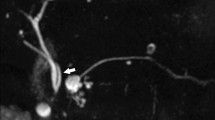Abstract
Acute cholecystitis, which is usually associated with gallstones, is one of the commonest surgical causes of emergency hospital admission and may be further complicated by mural necrosis, perforation, and abscess formation. Magnetic resonance imaging (MRI) is increasingly available in the emergency setting. Technically improved equipment and faster acquisition protocols allow excellent tissue contrast and MRI is now an attractive modality for imaging acute abdominal disorders. The use of MRI with MR cholangiopancreatography in the emergency setting provides rapid, noninvasive, and confident diagnosis or exclusion of acute cholecystitis and of coexistent choledocholithiasis. To familiarize the reader with these cross-sectional imaging appearances, this paper reviews MRI findings consistent with uncomplicated cholecystitis. These include gallbladder distension, intraluminal sludge and gallstones, impacted stones obstructing the gallbladder neck or cystic duct, thickening of the gallbladder wall, abnormal signal intensity and edematous stratification, and pericholecystic and perihepatic fluid, plus increased enhancement of the gallbladder wall and adjacent liver parenchyma when intravenous paramagnetic contrast is used. Furthermore, MRI allows prompt detection and comprehensive visualization and characterization of cholecystitis-related complications such as gangrene, perforation, pericholecystic abscess, and intrahepatic fistulization. Some previous literature reports, and our experience, suggest that, when available, MRI should be recommended to provide prompt and efficient triage of patients with suspected cholecystitis and inconclusive clinical, laboratory, and sonographic findings. It facilitates appropriate therapeutic planning, including the timing of surgery (emergency or delayed), approach (laparoscopic or laparotomic), and need for preoperative or intraoperative removal of stone(s) in the common bile duct.








Similar content being viewed by others
References
Catalano OA, Sahani DV, Kalva SP et al (2008) MR imaging of the gallbladder: a pictorial essay. Radiographics 28:135–155, quiz 324
Smith EA, Dillman JR, Elsayes KM et al (2009) Cross-sectional imaging of acute and chronic gallbladder inflammatory disease. AJR Am J Roentgenol 192:188–196
O'Connor OJ, Maher MM (2011) Imaging of cholecystitis. AJR Am J Roentgenol 196:W367–W374
Alobaidi M, Gupta R, Jafri SZ et al (2004) Current trends in imaging evaluation of acute cholecystitis. Emerg Radiol 10:256–258
Menu Y, Vuillerme MP (2002) Non-traumatic abdominal emergencies: imaging and intervention in acute biliary conditions. Eur Radiol 12:2397–2406
De Vargas MM, Lanciotti S, De Cicco ML et al (2006) Ultrasonographic and spiral CT evaluation of simple and complicated acute cholecystitis: diagnostic protocol assessment based on personal experience and review of the literature. Radiol Med 111:167–180
Shakespear JS, Shaaban AM, Rezvani M (2010) CT findings of acute cholecystitis and its complications. AJR Am J Roentgenol 194:1523–1529
Tkacz JN, Anderson SA, Soto J (2009) MR imaging in gastrointestinal emergencies. Radiographics 29:1767–1780
Stoker J, van Randen A, Lameris W et al (2009) Imaging patients with acute abdominal pain. Radiology 253:31–46
Singh A, Danrad R, Hahn PF et al (2007) MR imaging of the acute abdomen and pelvis: acute appendicitis and beyond. Radiographics 27:1419–1431
Watanabe Y, Nagayama M, Okumura A et al (2007) MR imaging of acute biliary disorders. Radiographics 27:477–495
Jung SE, Lee JM, Lee K et al (2005) Gallbladder wall thickening: MR imaging and pathologic correlation with emphasis on layered pattern. Eur Radiol 15:694–701
Altun E, Semelka RC, Elias J Jr et al (2007) Acute cholecystitis: MR findings and differentiation from chronic cholecystitis. Radiology 244:174–183
Yeh BM, Liu PS, Soto JA et al (2009) MR imaging and CT of the biliary tract. Radiographics 29:1669–1688
Kim YJ, Kim MJ, Kim KW et al (2005) Preoperative evaluation of common bile duct stones in patients with gallstone disease. AJR Am J Roentgenol 184:1854–1859
Schmidt S, Chevallier P, Novellas S et al (2007) Choledocholithiasis: repetitive thick-slab single-shot projection magnetic resonance cholangiopancreaticography versus endoscopic ultrasonography. Eur Radiol 17:241–250
Anderson SW, Lucey BC, Varghese JC et al (2006) Accuracy of MDCT in the diagnosis of choledocholithiasis. AJR Am J Roentgenol 187:174–180
Kochar K, Vallance K, Mathew G et al (2008) Intrahepatic perforation of the gall bladder presenting as liver abscess: case report, review of literature and Niemeier's classification. Eur J Gastroenterol Hepatol 20:240–244
Derici H, Kara C, Bozdag AD et al (2006) Diagnosis and treatment of gallbladder perforation. World J Gastroenterol 12:7832–7836
Chong VH, Lim KS, Mathew VV (2009) Spontaneous gallbladder perforation, pericholecystic abscess and cholecystoduodenal fistula as the first manifestations of gallstone disease. Hepatobiliary Pancreat Dis Int 8:212–214
Anderson BB, Nazem A (1987) Perforations of the gallbladder and cholecystobiliary fistulae: a review of management and a new classification. J Natl Med Assoc 79:393–399
Zerman G, Bonfiglio M, Borzellino G et al (2003) Liver abscess due to acute cholecystitis. Report of five cases. Chir Ital 55:195–198
Peer A, Witz E, Manor H et al (1995) Intrahepatic abscess due to gallbladder perforation. Abdom Imaging 20:452–455
Konno K, Ishida H, Sato M et al (2002) Gallbladder perforation: color Doppler findings. Abdom Imaging 27:47–50
Tsai MJ, Chen JD, Tiu CM et al (2009) Can acute cholecystitis with gallbladder perforation be detected preoperatively by computed tomography in ED? Correlation with clinical data and computed tomography features. Am J Emerg Med 27:574–581
Fitoz S, Erden A, Karagulle T, Akyar S (2000) Interruption of gallbladder wall with pericholecystic fluid: a CT finding of perforation. Emerg Radiol 7:253–255
Algin O, Ozlem N, Kilic E et al (2010) Gd-BOPTA-enhanced MR cholangiography findings in gall bladder perforation. Emerg Radiol 17:487–491
Author information
Authors and Affiliations
Corresponding author
Rights and permissions
About this article
Cite this article
Tonolini, M., Ravelli, A., Villa, C. et al. Urgent MRI with MR cholangiopancreatography (MRCP) of acute cholecystitis and related complications: diagnostic role and spectrum of imaging findings. Emerg Radiol 19, 341–348 (2012). https://doi.org/10.1007/s10140-012-1038-z
Received:
Accepted:
Published:
Issue Date:
DOI: https://doi.org/10.1007/s10140-012-1038-z




